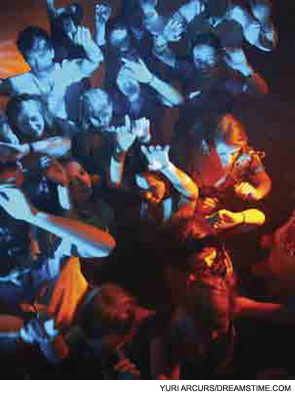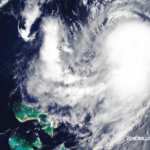
Editor’s note: This column continues Dr. Pisetsky’s saga to travel home to the U.S. from a rheumatology meeting in Europe after the Eyjafjallajokull volcano in Iceland erupted. We continue here with the van ride from Nice, France, to Madrid, Spain.
At 9 p.m. on the Saturday night after the volcano erupted, we took our dinner break at a truck stop in Spain. The sandwiches were remarkably tasty. The Spanish are wizards with jamon and, for Americans used to washing down a roadside dinner with a Big Gulp, San Miquel on tap or a small bottle of Sangre De Toro was a great treat. There was even an espresso machine that our truck stop barrista used to make cappuccinos. All was not well, however, since the restaurant was filled with a thick cloud of cigarette smoke that looked a lot nastier than the ash cloud that was supposedly jeopardizing Nice.
After dinner, I went next door to a convenience store to restock our supplies. When I entered the store, I was greeted by the shrill blast of a radio as the play-by-play announcer narrated a soccer match in a furious and overcharged way. Soccer broadcasts in Spanish—you know, GOOOOLLLLL!!!!—are a revelation to Americans used to the languid pace of baseball where a spit, windup, and pitch can consume an hour or two. Soccer broadcasting is hot stuff. Even a simple pass is described with the passion of a close play at the plate. I was amused to see that a major cookie company in Spain is called Bimbo.

Traversing On
The next part of the trip was quiet as another game of Geography fizzled after a promising start with Barcelona. The more technologically connected among us kept us informed of our location and the meanderings of the ash. Someone joked about a Mayan prediction for the end of the world in 2012. With knowledge that a dark cloud could block out the sun for serious global cooling, I was not sure that this was a matter of levity, even if one of our jokesters said it would be tough on any remaining dinosaurs.
We then entered a mountainous region and, as the terrain became rugged, our driver Salvatore eased off the pedal. In the ascent over the mountains, we hit a dense fog that slowed us down to 10 kilometers an hour. I must confess I felt a certain anxiety about the visibility and probably would have felt much more if I knew that, next to the road, a precipice dropped sharply.
At 3 a.m., we exited the fog and, in search of toilets, pulled into a truckstop whose sign said “Open 24 Hours.” The doors were locked, however, but in a restaurant next door there was a happening that looked like a cross between scenes in “Apocalypse Now” and Fellini’s “8 1/2”. Through misted windows, we could see about 50 people—the men in white shirts, the women in floral dresses, their faces gleaming with sweat—line dancing to thumping rock music. The dancers seemed in perpetual motion, as if driven relentlessly by an unknown force. Was this a marathon dance? The remnants of a destination wedding? Or some modern tribal gathering triggered by a call through the textosphere?
While we marveled at the scene, we were miffed that the truck-stop bathrooms were closed. With trepidation, we went behind some big rigs to do our business, trying to stay out of sight of the dancers. When a police car drove up, we hurried back into the van to forge on to Madrid, wondering what secret ritual we had come upon.
As one of the van riders said, we were approaching an asymptote. Salvatore was near exhaustion and started to go more and more slowly. After all, he had been driving 15 hours at that point, but we were near our destination in a part of Madrid that looks like Los Angeles. Our spirits soared when we saw a sign that said “Aeropuerto,” indicating the city’s Barajas Airport.
Going Home
At Terminal 1, my wife and I got out and said goodbye to our friends, wishing them good luck on their trip home. Having been warned of villainous pickpockets in Madrid, I moved my wallet from my back pocket to a safer spot. (In case pickpockets are reading, I am not going to disclose my secret hiding place, but you could get an idea from the TravelSmith catalog.) It was 6 a.m., and we chose to camp out at the US Airways desk to see if we could change our ticket and get on the Sunday flight instead of waiting until Monday. My body ached from sitting in one place for 16 hours, and a fierce fatigue pressed on my eyes. These were fibromyalgia symptoms, genuine 9-out-of-10 stuff.
Not knowing when the ticket counter would open, my wife and I decided to get some sleep and curled up on adjacent conveyor belts where the luggage goes off. I was very tired and worried that, fast asleep, I would get tagged and sent off to the cargo hold of a plane, sticking some poor passenger with a $20 fee for an overweight piece of baggage.
At 9 a.m., I was roused by the clatter of the arriving ticket agents and, heart beating quickly, waited in a snaking line of anxious travelers, feeling desperate as valuable minutes passed. Eventually, I got to the front and implored for help to an agent named Paloma who had red-purple hair and vibrant eyes. Saint Paloma, as we later called her, did some magic with her computer and got us seats on US Airways 741 at 12:35 p.m. and didn’t even hit us with a rebooking charge. We went off for breakfast and a jolt of espresso to keep us awake until boarding time.
When we finally boarded the plane, we were surprised to discover empty seats. While people were struggling to evacuate the continent, they couldn’t get to Madrid, no doubt stranded elsewhere because of a paucity of connecting flights. As in Casablanca, the trick was to get to an airport. For Victor Laszlo and Ilsa Lund, it was two letters of transit. For my wife and me, it was the van to Madrid.
Flight 741 and our connector were on time, and we returned home a mere 40 hours after starting our journey. Without even taking a shower, I went to bed and fell asleep instantly, although I was besieged by a barrage of hallucinatory dreams about armed guards with machine guns threatening to shoot me as I stood next to a cliff. Even if my sleep was mixed up, it was welcome.
I have enjoyed sharing this account. If nothing else, it has been cathartic and resembles expressive journal-writing activities that help people with post-traumatic stress disorder. In telling this tale, I have had a more serious purpose in mind. In my next column, I will discuss this purpose and try to connect what I learned about escaping a volcano from the work I do every day in the clinic.
Dr. Pisetsky is physician editor of The Rheumatologist and professor of medicine and immunology at Duke University Medical Center in Durham, N.C.
